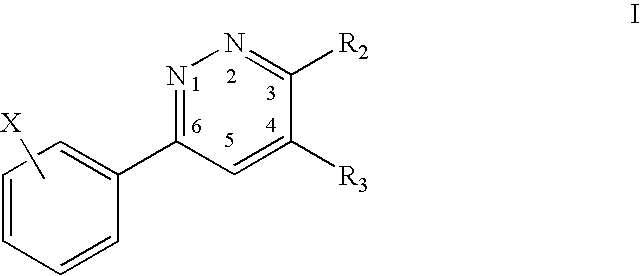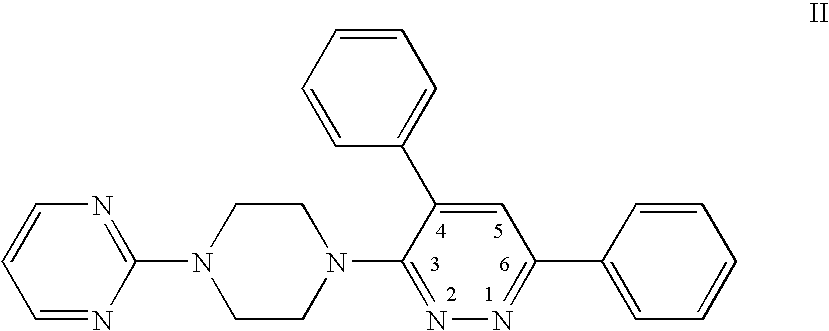3,4,6-Substituted pyridazines for treating neuropathic pain and associated syndromes
a pyridoxine and neuropathic pain technology, applied in the field of substituted pyridoxine compounds, can solve the problems of ineffective neuropathic pain management, few, if any, prospectively developed ethical drugs for the treatment of chronic pain, and often more difficult to treat chronic pain. , to achieve the effect of reducing or eliminating the symptoms of withdrawal syndrom
- Summary
- Abstract
- Description
- Claims
- Application Information
AI Technical Summary
Benefits of technology
Problems solved by technology
Method used
Image
Examples
example 1
Synthesis of 4,6-diphenyl-3-(4-(pyrimidin-2-yl)piperazin-1-yl)pyridazine (6)
[0188] The synthesis of 4,6-diphenyl-3-(4-(pyrimidin-2-yl)piperazin-1-yl)pyridazine (6) was carried out as provided below.
[0189] The overall reaction scheme is illustrated below.
A. Synthesis of 4-oxo-2,4-diphenylbutanenitrile (1)
[0190] trans-Chalcone (3 g) was dissolved in methanol (100 ml) and acetone cyanohydrin (4.53 g) and 10% aqueous Na2CO3 solution (2.5 ml) were added. The reaction mixture was heated to reflux for 6 hours and then cooled to room temperature. The product was crystallized by the addition of water (10 ml) and collected by filtration. 4-oxo-2,4-diphenylbutanenitrile (1) (2.71 g) was obtained as white crystals in 80% yield.
B. Synthesis of 4-oxo-2,4-diphenylbutanoic acid (2)
[0191] 4-oxo-2,4-diphenylbutanenitrile (2.6 g) was dissolved in 10N HCl (70 ml) and stirred at room temperature for 2 hours, then refluxed for 3 hours. The product crystallized from the reaction mixture upon coolin...
PUM
| Property | Measurement | Unit |
|---|---|---|
| time | aaaaa | aaaaa |
| time | aaaaa | aaaaa |
| temperature | aaaaa | aaaaa |
Abstract
Description
Claims
Application Information
 Login to View More
Login to View More - R&D
- Intellectual Property
- Life Sciences
- Materials
- Tech Scout
- Unparalleled Data Quality
- Higher Quality Content
- 60% Fewer Hallucinations
Browse by: Latest US Patents, China's latest patents, Technical Efficacy Thesaurus, Application Domain, Technology Topic, Popular Technical Reports.
© 2025 PatSnap. All rights reserved.Legal|Privacy policy|Modern Slavery Act Transparency Statement|Sitemap|About US| Contact US: help@patsnap.com



